| INDEX | 1300-1599 | 1600s | 1700s | 1800s | 1900s | CROSS-ERA | ETHNO | |
| MISCELLANY | CONTACT | SEARCH | |
In the 1850s and 60s, a woman was shaped chiefly by the crinoline which spread the skirt equally 360° round. There wasn't much in the way of garniture then, just maybe something to gather up the upper skirt and let the upper petticoat show, and a bit of embroidery on cuffs and collar. In the 1860s, the front of skirts flattened more while the bulk of cloth was gathered at the back. There still was a crinoline under it, if of a different form, until the late 1860s.
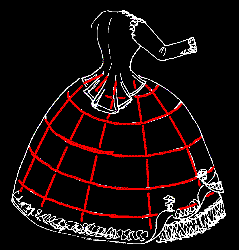
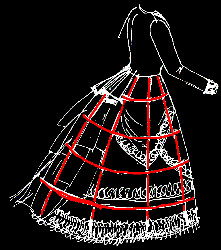
By the mid-1870s, the front of the dress was practically flat from throat to toe, and the volume had entirely fled to the back where it was piled into folds upon folds and topped with garniture, resulting in an extremely big backside, known as cul de paris (Paris Bottom), which was supported and shaped by an under-skirt device named tournure. The bodice (taille) was buttoned up high, except for ball dresses, the only dresses allowed a décolleté.
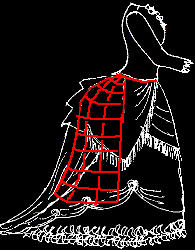

The tournure vanished around 1880, making way for narrow skirts that often stressed their narrowness with horizontally arranged garniture. In extreme cases, it looked as if the lady had tied her knees together. But the horizontal folds and vertical lines soon loosened again towards the apron (tablier) form that is so typical of the late 1880s.
In the latter half of the decade, the tournure returned, although smaller this time, and held its place for some years. Garniture became more and more luxuriant: More different materials, lace and embroidery were involved, and folding methods became ever more complicated.
The gathering of cloth away from the front into nice folds atop the false botty probably produced some liking for draping in general, but the underlying motivation, I believe, is a social one - see below. Some sources call the 1870s the Second Rococo (and the 1880s the 2nd Second etc etc), although the Rococo era hardly produced such an abundance of garniture outside the court.

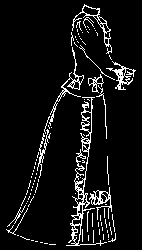
Towards the turn of the century the sleeves that had been tight throughout took on some volume until they became veritable haunches (leg of mutton). Apart from that, the upper part of the dress - the taille - didn't change much, except that the garniture gradually crept upwards from the skirt, i.e. whereas in the beginning (c. 1875) the taille had been plain and the skirt lavishly adorned, in the end (towards 1910) the skirt was plain and only the taille adorned. The top of the dress remained tight and stiff throughout, although the garniture sometimes created the impression of looseness.
In the early 1890s, the waists were smaller than ever before and remained very small until the arrival of the straight-fronted corset. The turnure vanished and left flowing, somewhat flaring skirts.

From the late 1870s until c.1910, the standing collar was standard. At the turn of the century, Art Nouveau style influenced fashion: Not only the patterns of embroidery, but also the lines of the dresses with relatively plain skirts that flared at the hem followed the new aesthetic. The most important change, however, is that of the fashionable body form. From the 1850 until then, a female body was formed by corsets with a coca-cola-bottle line both seen from front and side, i.e. below the waist the corset did allow some space for a belly.
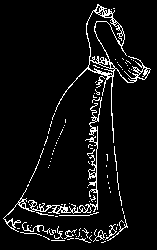
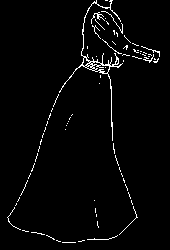
Now, corsets had a straight front and reached down below the hips, hampering any decent use of the hip joints. The belly was pressed back, the breast and bottom out, resulting in a forward-leaning posture and an overall s-curve shape which remained fashionable until corsets went out of style.
With the advent of the working woman, blouse-skirt combinations became acceptable in everyday clothing.
Bicycles made women wear wide trousers, clothing for automobile "sport" was invented.
Not the least, the reform movement came in, trying to banish the corset, but
at first only succeeding in making the empire dress fashionable once again.
For more about the reform movement, see reformed
clothing page of the HowTo section.
This page has been divided into two parts
- please go on to part two.
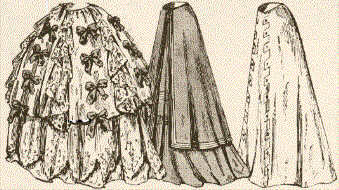
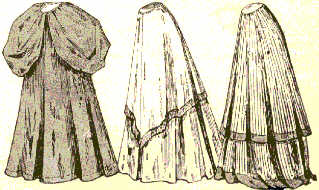
basic forms of skirt garniture: crinoline, polonaise, tablier,
paniers, tunique, double skirt
Content, layout and images of this page
and any sub-page of the domains marquise.de, contouche.de, lumieres.de, manteau.de and costumebase.org are copyright (c) 1997-2022 by Alexa Bender. All rights reserved. See Copyright Page. GDPO
This work is licensed under a Creative Commons License.